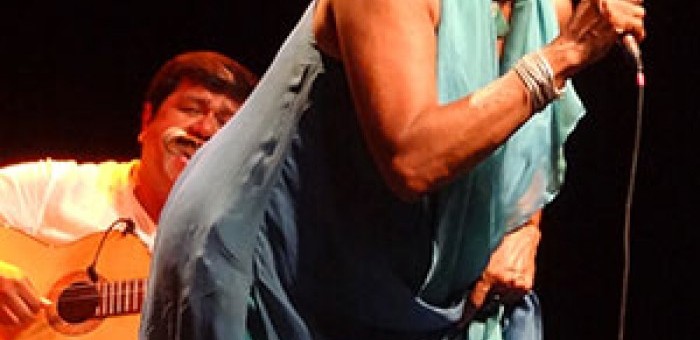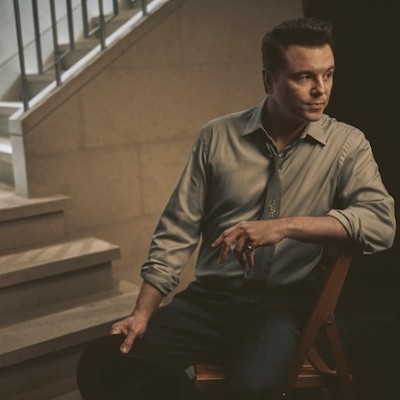Dec 9, 2025 12:28 PM
In Memoriam: Gordon Goodwin, 1954–2025
Gordon Goodwin, an award-winning saxophonist, pianist, bandleader, composer and arranger, died Dec. 8 in Los Angeles.…

Susana Baca and Ernesto Hermoza (back) at the 2013 Panama Jazz Festival (Photo: Shannon J. Effinger)
(Photo: )The 10th anniversary of the Panama Jazz Festival marked a pivotal year in the country’s development. Held in the nation’s capital, Panama City, where roadways are under renovation and a new subway system is currently under construction, the theme of this year’s festival mirrored much of the revitalization efforts of its host city — a commitment to both the people and the future.
At a kickoff reception on the rooftop of the Miraflores Visitors Center, guests had the rare opportunity to mingle with some of this year’s headliners, including pianist Herbie Hancock, saxophonist Wayne Shorter and pianist Danilo Pérez, who is also founder of the festival. Everyone present that evening had perfect view of the massive vessels that passed through the Panama Canal; to see artists such as Shorter watch incoming ships with the same level of wonder made the experience even more memorable.
Shortly after Pérez and Panama City Mayor Roxana Méndez presented Hancock with the keys to the city at the Municipal House, both Hancock and Shorter were whisked off to the Danilo Pérez Foundation in the heart of Old Town Panama, where they were honored as guests. Formed in 2005 by Pérez, a native Panamanian, the foundation gives young people year-round access to music-education programs through artist mentorship, much of which is due to the overall support of the festival.
“Jazz has been used to solve social class issues,” said Pérez during the key ceremony. Last November, the pianist was recognized for his philanthropic efforts when he was named a UNESCO Artist for Peace. Clearly moved by the children’s playing at the foundation, Hancock could not contain his excitement as he jumped right in tandem, turning the moment into an old-fashioned jam session.
The enthusiasm from that day carried well into the weeklong series of concerts, which were held mainly at Teatro Anayansi in the Centro de Convenciones Atlapa. On Wednesday, the inaugural night, patrons were photographed on a red carpet alongside models wearing custom garments made out of posters from the previous festivals. Both the children and instructors of the Danilo Pérez Foundation, who performed many of Hancock’s compositions, more than impressed the crowd with the level of control and passion in their playing. Their youthful energy gave Hancock an added zeal during his solo performance as he returned to his modal jazz roots on exploratory reworkings of his signature compositions. While taking the audience to church on “Watermelon Man,” which was full of gospel chords and blues riffs, he redefined the meaning of hard bop on “Cantaloupe Island” as he relayed the melody line and beat the piano like a conga drum.
Guitarist Bill Frisell devoted much of his set to his 2011 album, All We Are Saying (Savoy), when he opened the following night. While Frisell remained almost too faithful to the now well-known chords of John Lennon’s “You’ve Got To Hide Your Love Away” and “Beautiful Boy,” it was Jenny Scheinman’s violin that stood out from the melody line.
For many, Frisell was the calm before the splendid storm before the arrival of the great Afro-Peruvian singer/songwriter Susana Baca. Dressed in a flowing, silk blue dress, Baca moved like the water itself, in tandem with rhythmic guitar and percussion on songs like “Negra Presuntuosa.” Underrated as a performer, Baca possessed an ethereal quality as she glided with the music, yet there is a deep connection to her roots in both the dominance of the conga drum and her socially progressive lyrics.
The tension of this year’s festival came from the sudden illness of Shorter, and the rumors speculated up through Friday evening, the night of his quartet’s performance, on whether or not another headliner would have to replace him. When Shorter walked out on the stage, the crowd came to its feet, and the power in his playing that night was nothing short of a revelation. On songs like “Joy Rider,” Pérez, bassist John Patitucci and drummer Brian Blade served as a tight, formidable anchor to Shorter’s lyrical solos on alternating tenor and soprano saxophones. Shorter’s imaginative improvisations that night seemed to have been touched by the spirit of a higher power.
From master classes with international artists, including Pérez’s other initiative from his alma mater, the Berklee Global Jazz Institute, to jam sessions into the wee hours highlighting new voices such as tenor saxophonist Jahaziel Arrocha—both a Berklee and Foundation alum—the Panama Jazz Festival propagated the transformative power of music.
—Shannon J. Effinger

Goodwin was one of the most acclaimed, successful and influential jazz musicians of his generation.
Dec 9, 2025 12:28 PM
Gordon Goodwin, an award-winning saxophonist, pianist, bandleader, composer and arranger, died Dec. 8 in Los Angeles.…

Flea has returned to his first instrument — the trumpet — and assembled a dream band of jazz musicians to record a new album.
Dec 2, 2025 2:01 AM
After a nearly five-decade career as one of his generation’s defining rock bassists, Flea has returned to his first…

“It’s a pleasure and an honor to interpret the music of Oscar Peterson in his native city,” said Jim Doxas in regard to celebrating the Canadian legend. “He traveled the world, but never forgot Montreal.”
Nov 18, 2025 12:16 PM
In the pantheon of jazz luminaries, few shine as brightly, or swing as hard, as Oscar Peterson. A century ago, a…

Dec 11, 2025 11:00 AM
DownBeat presents a complete list of the 4-, 4½- and 5-star albums from 2025 in one convenient package. It’s a great…

Seth MacFarlane takes a turn from his television and film career to sing arrangements made for Frank Sinatra, but never recorded.
Nov 18, 2025 12:04 PM
“I’m not gonna lie to you — I don’t know why I thought this was about The Naked Gun, but I’m happy it’s…